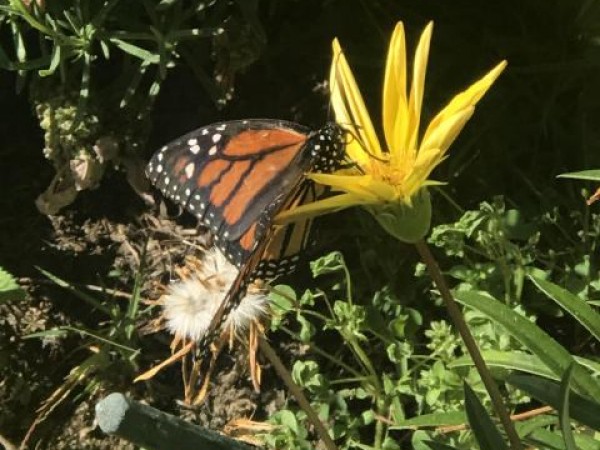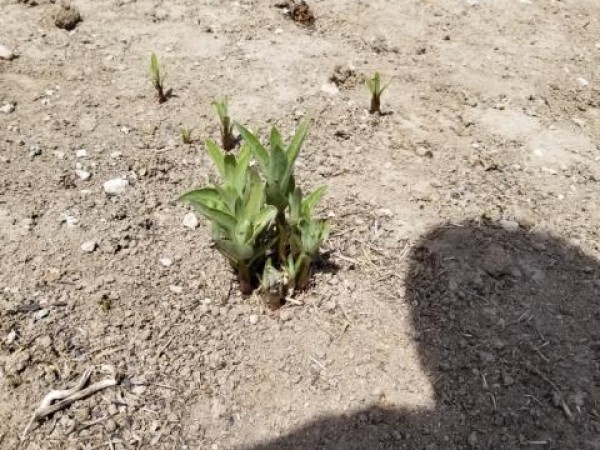Western Monarch Spring Report #10
By Gail Morris
Moving North
Monarchs were seen in the higher elevations of New Mexico this week for the first time this season in several locations. Meanwhile as near record breaking temperatures sizzle in the lower deserts of Arizona and California, monarchs will likely move into the higher elevations of Arizona and further north. Look for fruit and native trees in bloom and early flowers to sustain breeding monarchs while egg-laying on freshly emerged milkweed as they fly through.
Monarch & Milkweed Sightings
Mary in Valarde, New Mexico, spotted her first monarch of the season on May 1. It was a faded, pale orange color, flying along bosque-meadow edge. “This is rural agricultural and pasture land. We get several species of butterflies here and I do recognize the differences. We had a storm of Painted Ladies about 3 weeks ago and the Tiger Swallowtails are lazily flying around everyday for the last 3 or 4 days. My husband is a very avid butterfly watcher and knows what is around here. As a boy he tagged Monarchs in the late 1960's in Houston, Texas when that project first started.”
The next day, Stephanie saw a monarch in her yard in Albuquerque, New Mexico. “1 fresh male - not a reimmigrant [sic]. Exhibiting territorial behavior. Flying around milkweed, showy and horsetail. 4:50 PM 86 degrees.” Stephanie has followed the monarch migration for many years and created a rich habitat to draw monarchs to her yard. “I wish I had a photo, the Monarch didn't stick around long enough. It was a very bright, a new Monarch butterfly on a warm afternoon. I have lots of Showy milkweed and Horsetail milkweed that are a foot tall and very lush, no aphids yet, that is what attracted it. So I am looking out for eggs on the milkweed now.”
While monarchs are heading towards their summer breeding grounds, some are still in the coastal California regions. Tracy in Los Angeles saw her first month on May 3. “First one I've seen in months near my home.”
Milkweed is up in Idaho and waiting for monarchs. Bradford discovered milkweed emerging on May 5 in Hazelton. “I sent seeds to my in-laws last year. This year the plants are coming back strong. Asclepias speciosa.”
May Monitoring
Fresh and new monarchs are emerging, so keep your camera handy when you are outdoors. Send in your photos and describe what you see. Are adult monarchs’ wings new and bright colored or worn and faded? Looking for larvae on nearby milkweed? Look early in the morning when they are more likely to be feeding near the top of plants. As temperatures warm larvae may be harder to find as they find a cooler place deeper in the plant. Check milkweed plants for eggs. They are usually on the underside of leaves.
Monarchs will now quickly move north and east into the summer breeding grounds laying eggs hopefully in your neighborhood as they pass through. Warm temperatures in the forecast will hastening their Spring travels. It’s not unusual to find larvae first without even seeing an adult monarch that flew through on their journey. So don’t give up looking for adult monarchs and their offspring each week.
Report your Sightings
Every monarch you see – whether an adult, egg, larvae or pupae – is important to report and we look forward to reading the observations that you send to Journey North this season! Are native milkweeds up and ready for monarchs where you live? Are native milkweeds blooming? Send in your photos!
Gail Morris is the Coordinator of the Southwest Monarch Study (www.swmonarchs.org), a Monarch Watch Conservation Specialist, and the Vice President of the Monarch Butterfly Fund and the Central Arizona Butterfly Association. The Western Monarch Population News is based on comments provided to Gail Morris. We hope to increase the number of sightings and therefore photos and comments entered into the Journey North. We rely on the volunteers who communicate regularly with Gail and who agree to participate in our effort to increase awareness of the population of western Monarchs.

